Nineteenth-Century Tesuque Pueblo Rain God Figurine - C3618C
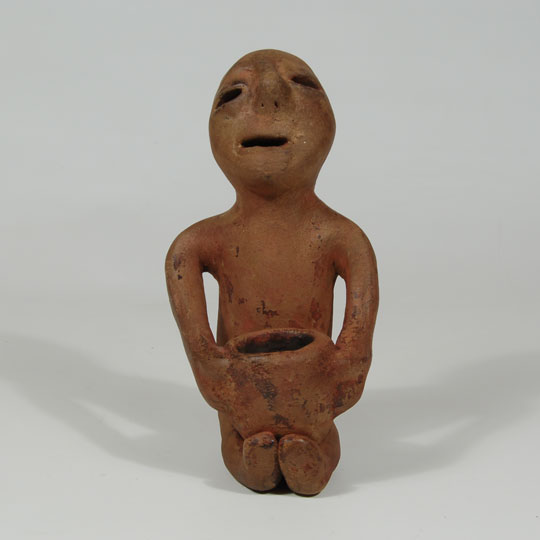 Santa Fe was becoming a tourist destination in the 1880s. The Atchison, Topeka and Santa Fe Railway train made transportation to the town convenient. The town was a Territory of the United States, not yet a state. That fact, along with the rich heritage of the Indian cultures, the healthy climate, and the beauty of the region made Santa Fe an exotic vacation for Easterners. Santa Fe merchants were eager to attend to the needs and desires of these travelers and it is in this realm that the Tesuque Rain God figurines were developed.
Santa Fe was becoming a tourist destination in the 1880s. The Atchison, Topeka and Santa Fe Railway train made transportation to the town convenient. The town was a Territory of the United States, not yet a state. That fact, along with the rich heritage of the Indian cultures, the healthy climate, and the beauty of the region made Santa Fe an exotic vacation for Easterners. Santa Fe merchants were eager to attend to the needs and desires of these travelers and it is in this realm that the Tesuque Rain God figurines were developed.
Gallup Ceremonial 1938 Award Winning Red Plate by Rose Gonzales - C3792E
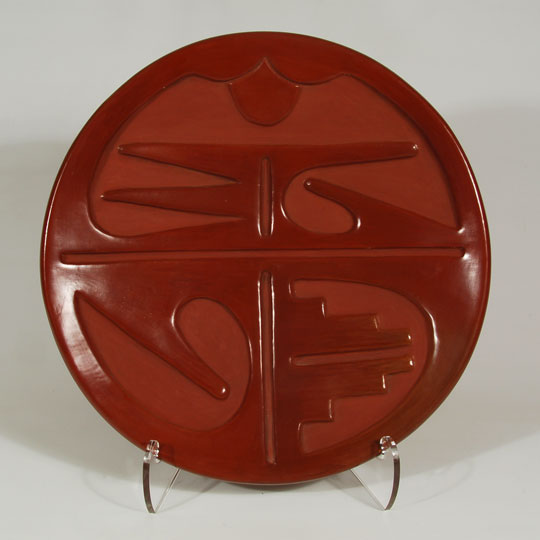 Rose Cata Gonzales was originally from Ohkay Owingeh (San Juan) Pueblo. She married Robert Gonzales of San Ildefonso Pueblo and moved there with him. Rose was a sister of Pomasena Sanchez. She was the mother of Jose H. Rainbird Gonzales,Tse-Pé Gonzales, and Marie Gonzales Yazzie. Rose learned pottery making from Ramona Sanchez Gonzales, her mother-in-law. Rose's parents died from the swine flu epidemic of 1918, leaving Rose and her sister Pomasena orphaned. The girls survived by staying at the Santa Fe Indian School. Mary Cata, a relative, adopted and cared for the girls.
Rose Cata Gonzales was originally from Ohkay Owingeh (San Juan) Pueblo. She married Robert Gonzales of San Ildefonso Pueblo and moved there with him. Rose was a sister of Pomasena Sanchez. She was the mother of Jose H. Rainbird Gonzales,Tse-Pé Gonzales, and Marie Gonzales Yazzie. Rose learned pottery making from Ramona Sanchez Gonzales, her mother-in-law. Rose's parents died from the swine flu epidemic of 1918, leaving Rose and her sister Pomasena orphaned. The girls survived by staying at the Santa Fe Indian School. Mary Cata, a relative, adopted and cared for the girls.
Santa Clara Pueblo Black Carved Pottery Masterpiece by Mela Youngblood - C3792B
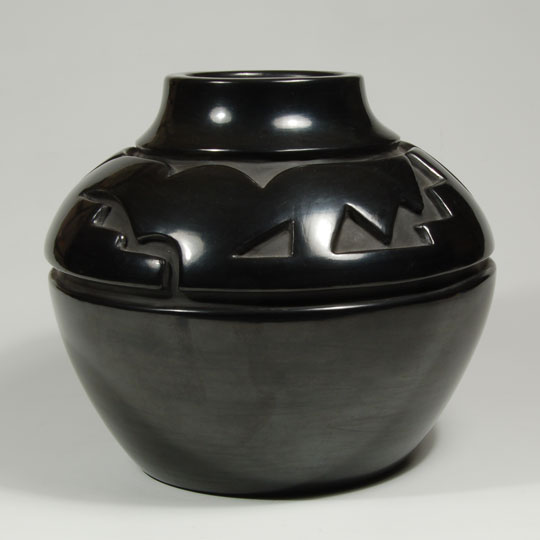 Mela Tafoya Youngblood (1931-1991) Misteltoe Yellow was the daughter of Margaret Tafoya, granddaughter of Sara Fina Tafoya, and mother of Nancy Youngblood. Mela won awards practically every year from 1976 through 1989 at Santa Fe Indian Market, so there is no doubt about her talent and the respect given her. It is unfortunate that she passed away at such a young age. She was still very active at that time.
Mela Tafoya Youngblood (1931-1991) Misteltoe Yellow was the daughter of Margaret Tafoya, granddaughter of Sara Fina Tafoya, and mother of Nancy Youngblood. Mela won awards practically every year from 1976 through 1989 at Santa Fe Indian Market, so there is no doubt about her talent and the respect given her. It is unfortunate that she passed away at such a young age. She was still very active at that time.
Santa Clara Pueblo Round Jar with Green Slip by Art Cody - C3771M
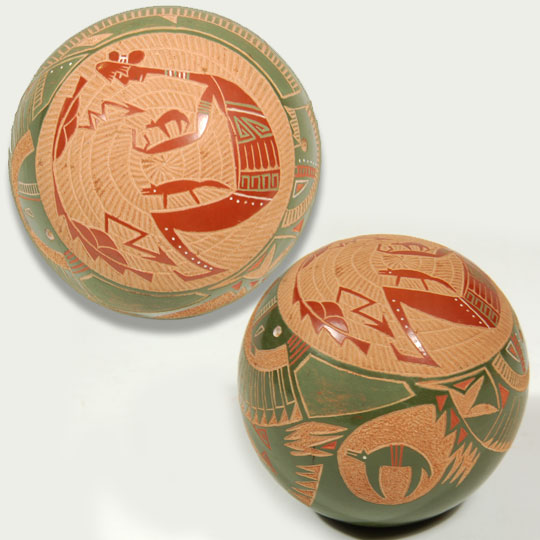 Art Cody (1943-1985) Arthur Haungooah was the grandson of the famous Kiowa medicine man and scout James Haungooah, also known as Silverhorn (1861-1941). The first Haungooah became famous in the 19th century for his fantastic ledger drawings of life on the Southern Plains.
Art Cody (1943-1985) Arthur Haungooah was the grandson of the famous Kiowa medicine man and scout James Haungooah, also known as Silverhorn (1861-1941). The first Haungooah became famous in the 19th century for his fantastic ledger drawings of life on the Southern Plains.
The second Haungooah married Martha Suazo of Santa Clara Pueblo in 1972. She was a potter and encouraged him to decorate her work. He became an outstanding decorator of miniature pottery. He was one of the early artists to perfect the sgraffito style of carving. Eventually, he moved from designing others' pottery to making his own.
Santa Clara Pueblo Tall and Slim Black Carved Jar by Elizabeth Naranjo - C3792F
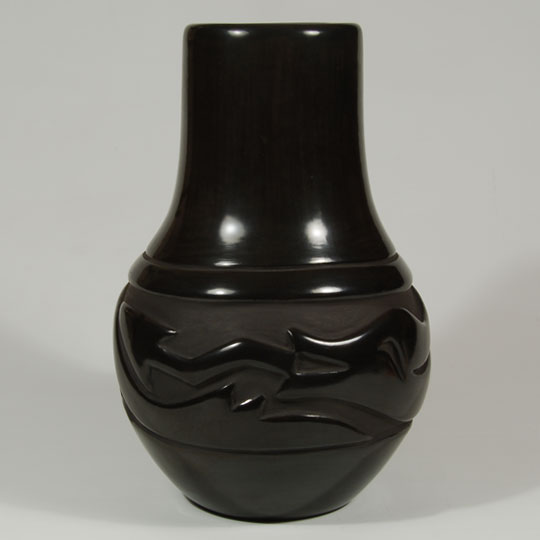 This jar by Elizabeth Naranjo was made as a work of art by a potter who regularly produces Santa Clara Pueblo's finest black polished and carved wares. Elizabeth is a daughter of Pablita Chavarria, who was a potter. Her sisters are Clara Shije, Reycita Naranjo, Florence Browning and Mary Singer, all of whom are recognized as exceptional potters. This is a very talented family.
This jar by Elizabeth Naranjo was made as a work of art by a potter who regularly produces Santa Clara Pueblo's finest black polished and carved wares. Elizabeth is a daughter of Pablita Chavarria, who was a potter. Her sisters are Clara Shije, Reycita Naranjo, Florence Browning and Mary Singer, all of whom are recognized as exceptional potters. This is a very talented family.
Original Painting Entitled “Doe and Fawn” by Theodore Suina (Ku-Pe-Ru) - C3653C
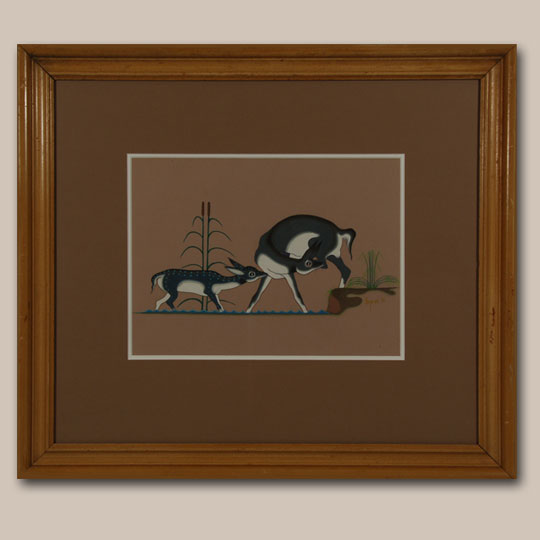 In 1939, architect John Gaw Meem commissioned a number of Native artists to paint murals on a building he designed for the Maisel Company in Albuquerque. Popovi Da, Pablita Velarde and Pop Chalee painted northern Pueblo subjects, while Ben Quintana, Ku-Pe-Ru and Joe H. Herrera did Keres motifs. Other Indians painted subjects from their tribal affiliation. Ku-Pe-Ru painted a Corn Dancer. The building still exists in downtown Albuquerque and the murals are still visible and in excellent condition.
In 1939, architect John Gaw Meem commissioned a number of Native artists to paint murals on a building he designed for the Maisel Company in Albuquerque. Popovi Da, Pablita Velarde and Pop Chalee painted northern Pueblo subjects, while Ben Quintana, Ku-Pe-Ru and Joe H. Herrera did Keres motifs. Other Indians painted subjects from their tribal affiliation. Ku-Pe-Ru painted a Corn Dancer. The building still exists in downtown Albuquerque and the murals are still visible and in excellent condition.
Original Painting Entitled “Pronghorn Bucks” by Yel-Ha-Yah (Charles Lee) - C3653A
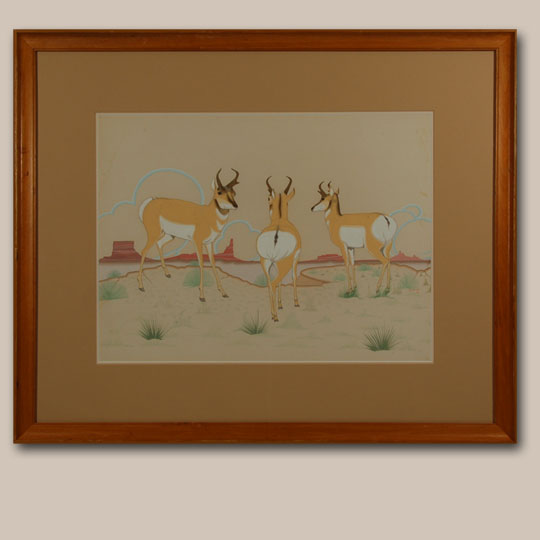 "One Navajo artist whose paintings never fail to appeal in their quiet tone and delicacy of color is Charlie Lee. 'Yel-Ha-Yah' is his signature, and he has explained it as a shortening of Hush-Ka-Yel-Ha-Yah, meaning 'warrior who came out,' a name given him by his grandmother. And a more peaceful warrior never existed.
"One Navajo artist whose paintings never fail to appeal in their quiet tone and delicacy of color is Charlie Lee. 'Yel-Ha-Yah' is his signature, and he has explained it as a shortening of Hush-Ka-Yel-Ha-Yah, meaning 'warrior who came out,' a name given him by his grandmother. And a more peaceful warrior never existed.
"Lee was born in western New Mexico on April 14, 1926, near Red Rock, Arizona. He started school at the age of seven, attending at one time or another St. Michaels Catholic Indian School, Southern Ute Indian School, Red Rock Day School, and Shiprock School, and Santa Fe Indian School in his senior year. "When he was nine or ten years old, Charlie Lee often took care of his grandfather's horses...(He) has often spoken lovingly and proudly in the same breath of the long line of palominos, pintos, buckskins, and a burro at the end, going to water. "In his senior year at the Santa Fe Indian School, Lee took art under Geronima Montoya. Upon his graduation in 1946, he returned to the Navajo Reservation. Because he 'did not feel at home at all,' he returned to the school in Santa Fe and undertook more work." Tanner 1973
Original Painting of Male and Female Corn Dancers by J.D. Roybal - 25386
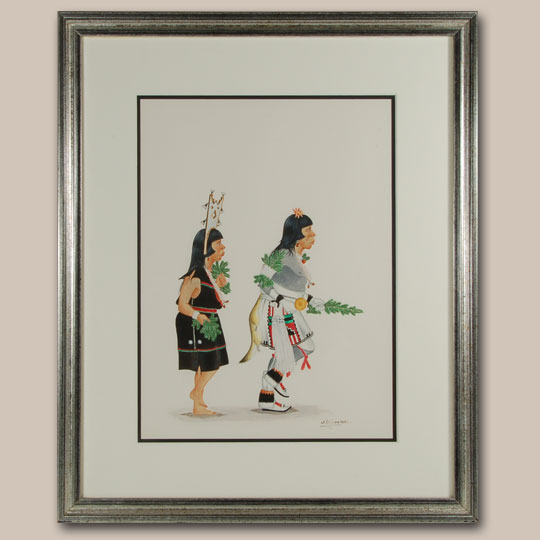 José Disiderio (J.D.) Roybal [1922-1978] Oquwa - Rain God grew up under the artistic influence of his well-known uncle Awa Tsireh. Early in his education, he studied at St. Catherine's School in Santa Fe and at the Business College of Santa Fe. In the early 1950s he and Julia were married and it was then that he started producing pueblo dance designs on hand-painted Christmas cards. By 1955 he was seriously painting larger works and recognition for his talents came from the Heard Museum in Phoenix and the Philbrook in Oklahoma. He received a consistent string of first prizes in painting for each year since the Eight Northern Pueblos Arts and Crafts Shows began.
José Disiderio (J.D.) Roybal [1922-1978] Oquwa - Rain God grew up under the artistic influence of his well-known uncle Awa Tsireh. Early in his education, he studied at St. Catherine's School in Santa Fe and at the Business College of Santa Fe. In the early 1950s he and Julia were married and it was then that he started producing pueblo dance designs on hand-painted Christmas cards. By 1955 he was seriously painting larger works and recognition for his talents came from the Heard Museum in Phoenix and the Philbrook in Oklahoma. He received a consistent string of first prizes in painting for each year since the Eight Northern Pueblos Arts and Crafts Shows began.
Historic San Ildefonso Black on Red Gourd Shape Jar by Tonita Martinez Roybal - C3776K
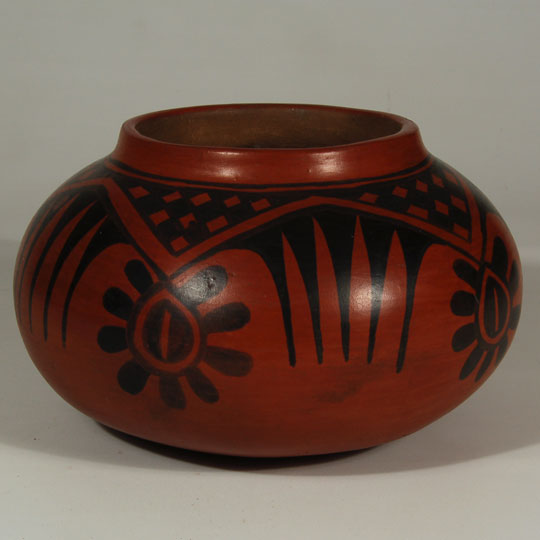 Tonita Martinez Roybal (1892-1945) Antonita has been acclaimed to have been one of the finest potters of the twentieth century. She was a contemporary of Maria Martinez and sometimes collaborated with her. Roybal, in her early years, not only made all her own pottery, she decorated it as well. Only after she married Juan Cruz Roybal in 1916 did she have someone else paint the pottery for her. After 1930, her husband painted most of her pottery.
Tonita Martinez Roybal (1892-1945) Antonita has been acclaimed to have been one of the finest potters of the twentieth century. She was a contemporary of Maria Martinez and sometimes collaborated with her. Roybal, in her early years, not only made all her own pottery, she decorated it as well. Only after she married Juan Cruz Roybal in 1916 did she have someone else paint the pottery for her. After 1930, her husband painted most of her pottery.
Small Red Jar with Sgraffito Avanyu Design by Grace Medicine Flower - C3771H
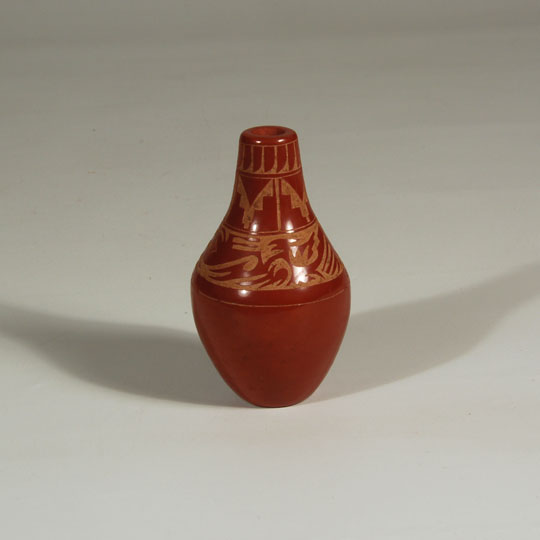 Grace Medicine Flower stated "Sgraffito carving is very precise and painstaking work. One of the marks of a true artist is not only the design but also the fine-line work making up the design. Carved after the pot is dried and polished, but before it is fired, one slip of the knife, one tiny chip and the design can be ruined. There is no chance for erasure, there is no chance for recovery."
Grace Medicine Flower stated "Sgraffito carving is very precise and painstaking work. One of the marks of a true artist is not only the design but also the fine-line work making up the design. Carved after the pot is dried and polished, but before it is fired, one slip of the knife, one tiny chip and the design can be ruined. There is no chance for erasure, there is no chance for recovery."
Untitled Summer Monsoon Season Storm Landscape Painting by Tony Abeyta - 25857
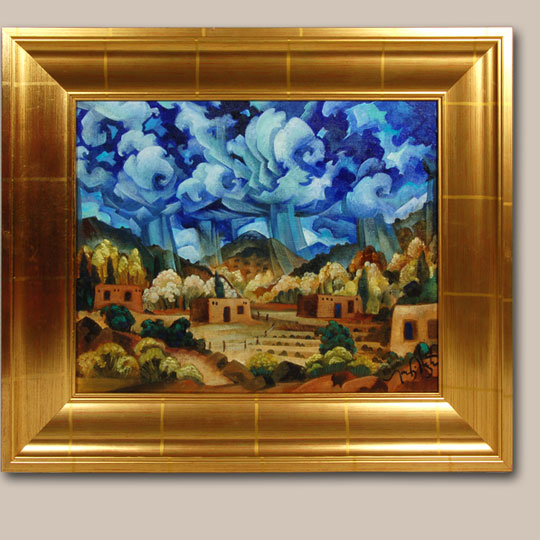 Tony Abeyta has achieved the emotional and artistic expression that most artists can only portray on a much larger scale. There are the dynamics of billowing clouds producing rain in concentrated definable areas as happens in the mountains of New Mexico. The landscape is clear and beautiful, only obliterated by heavy rainfall in restricted areas. The colors of the earth, its plants and trees, and reflections from the intense sun all stand out in harmony in this strong yet peaceful landscape. One has to experience one of these summer storms to realize how powerful they are.
Tony Abeyta has achieved the emotional and artistic expression that most artists can only portray on a much larger scale. There are the dynamics of billowing clouds producing rain in concentrated definable areas as happens in the mountains of New Mexico. The landscape is clear and beautiful, only obliterated by heavy rainfall in restricted areas. The colors of the earth, its plants and trees, and reflections from the intense sun all stand out in harmony in this strong yet peaceful landscape. One has to experience one of these summer storms to realize how powerful they are.
Hopi Polychrome Jar with Open Feather Design by Garnet Pavatea - C3321A
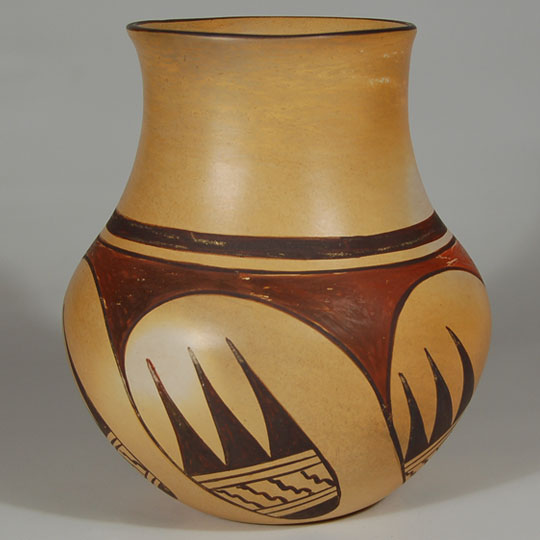 Those who knew Garnet Pavatea are aware that for most of her career, she fired her pottery in the traditional outdoor manner. Later, in the last decade of her life, she had both lower legs amputated from the results of diabetes and was then unable to fire outdoors. She purchased an electric kiln and fired her pots in that manner. This jar is one of her earlier (circa 1950s) and displays evidence of an outdoor firing. There is a fire cloud on one side that is faint but discernible.
Those who knew Garnet Pavatea are aware that for most of her career, she fired her pottery in the traditional outdoor manner. Later, in the last decade of her life, she had both lower legs amputated from the results of diabetes and was then unable to fire outdoors. She purchased an electric kiln and fired her pots in that manner. This jar is one of her earlier (circa 1950s) and displays evidence of an outdoor firing. There is a fire cloud on one side that is faint but discernible.
Zuni Pueblo Carved Turquoise Frog Mounted on Silver Base - C3695G
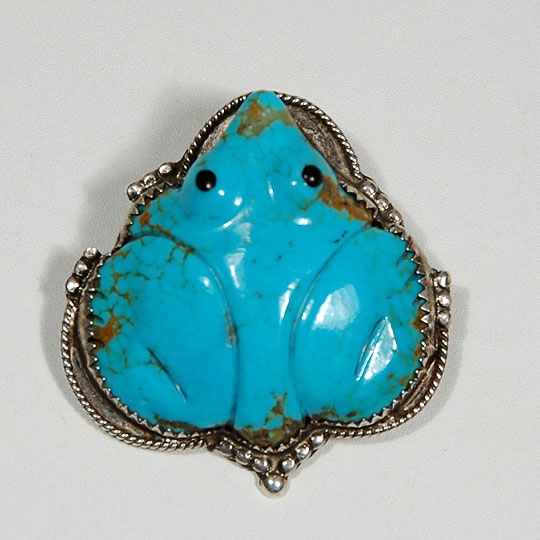 Zuni lapidary artisans are well known for their carved animal fetishes such as this exquisitely carved turquoise frog with jet eyes. The body contours have been inscribed into the stone. The frog is mounted in a silver bezel and placed on a silver sheet that is fitted for use as a pin or a pendant. The back is stamped ZUNI but no artisan's name.
Zuni lapidary artisans are well known for their carved animal fetishes such as this exquisitely carved turquoise frog with jet eyes. The body contours have been inscribed into the stone. The frog is mounted in a silver bezel and placed on a silver sheet that is fitted for use as a pin or a pendant. The back is stamped ZUNI but no artisan's name.
Hopi Pueblo Narrow Band Silver Overlay Bracelet by Watson Honanie - C3695F
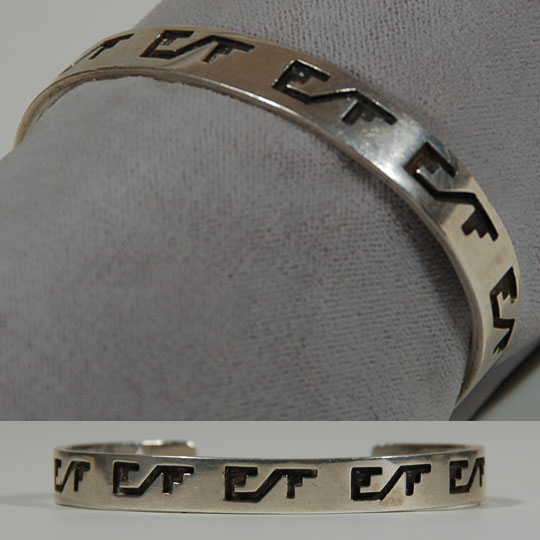 The Hopi Arts & Crafts Co-op Guild was formed in 1947, after World War II, when returning Hopi servicemen were trained at a silversmithing school founded under the G.I. bill. The late Paul Saufkie, Sr. was the technical instructor and the late Fred Kabotie, noted Hopi artist and designer, taught design. Although many techniques of silver work were used, the overlay style gradually emerged as the dominate style. This simple, unique, elegant jewelry is now considered essentially the Hopi style of jewelry.
The Hopi Arts & Crafts Co-op Guild was formed in 1947, after World War II, when returning Hopi servicemen were trained at a silversmithing school founded under the G.I. bill. The late Paul Saufkie, Sr. was the technical instructor and the late Fred Kabotie, noted Hopi artist and designer, taught design. Although many techniques of silver work were used, the overlay style gradually emerged as the dominate style. This simple, unique, elegant jewelry is now considered essentially the Hopi style of jewelry.
Navajo Five Band Silver Bracelet - C3695E
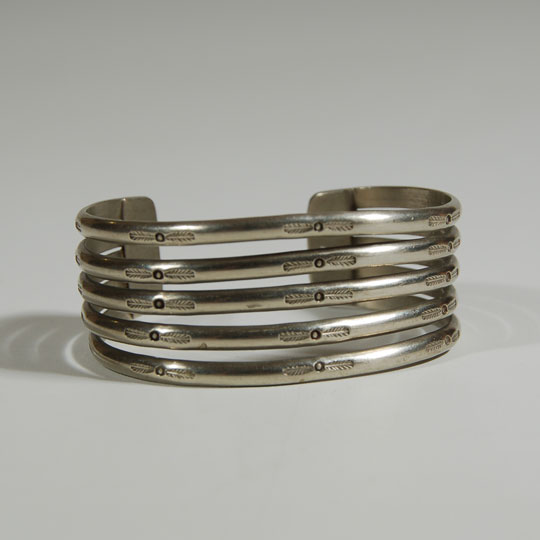 This bracelet consists of five domed and stamped silver strips separated at the top and anchored at the ends with a silver bar. The two outer strips are slightly higher at the center than the three inner ones, acting as guards. The simple stamped design of double feathers is a beautiful example of Navajo made Southwest Indian Jewelry.
This bracelet consists of five domed and stamped silver strips separated at the top and anchored at the ends with a silver bar. The two outer strips are slightly higher at the center than the three inner ones, acting as guards. The simple stamped design of double feathers is a beautiful example of Navajo made Southwest Indian Jewelry.
Historic Hopi Jar with Polacca Slip and Red Rim, ca 1885 by Nampeyo of Hano - C3776H
Nampeyo of Hano was in the right location at the right time. Excavations at the prehistoric Sikyatki ruins, the publicity of the Hopi Snake Dance by the Fred Harvey Company, the enthusiasm of local trader Thomas Keam, and the inherent artistic talent of Nampeyo combined to make her the preeminent potter at Hopi. This was not easy on her traditional Hopi life, as it was not the custom for someone to stand out as better than others. Nampeyo was chided by her neighbors for doing so.
Very Large Hopi Pueblo Jar with Graceful Stylized Bird by Nampeyo of Hano - C3776D
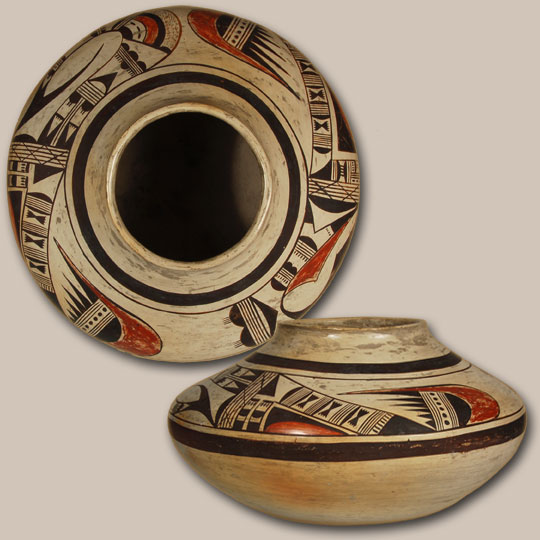 When Nampeyo of Hano was first making pottery, she was most likely making only utilitarian wares. That is what she had learned from her mother, White Corn, who passed away sometime between 1901 and 1909. Nampeyo's mother and grandmother were her mentors. It was not until Nampeyo's husband Lesso was working with the excavation party at the prehistoric Hopi Sikyatki Pueblo ruins that Nampeyo was introduced to the magnificent prehistoric Sikyatki pottery shards that would influence her life's work and that of her descendants.
When Nampeyo of Hano was first making pottery, she was most likely making only utilitarian wares. That is what she had learned from her mother, White Corn, who passed away sometime between 1901 and 1909. Nampeyo's mother and grandmother were her mentors. It was not until Nampeyo's husband Lesso was working with the excavation party at the prehistoric Hopi Sikyatki Pueblo ruins that Nampeyo was introduced to the magnificent prehistoric Sikyatki pottery shards that would influence her life's work and that of her descendants.
Very Small Nampeyo Jar with Whirling Log Design by Nampeyo of Hano - C3776F
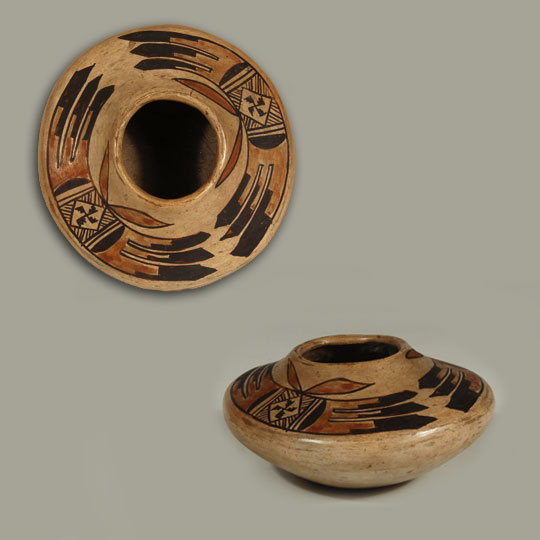 When Nampeyo of Hano was first making pottery, she was most likely making onlyutilitarian wares. That is what she had learned from her mother, White Corn -Kochaka, who passed away sometime between 1901 and 1909. Nampeyo's mother and grandmother were her mentors. It was not until Nampeyo's husband Lesso was working with the excavation party at the prehistoric Hopi Sikyatki Pueblo ruins, that Nampeyo was introduced to the magnificent prehistoric Sikyatki pottery shards that would influence her life's work and that of her descendants.
When Nampeyo of Hano was first making pottery, she was most likely making onlyutilitarian wares. That is what she had learned from her mother, White Corn -Kochaka, who passed away sometime between 1901 and 1909. Nampeyo's mother and grandmother were her mentors. It was not until Nampeyo's husband Lesso was working with the excavation party at the prehistoric Hopi Sikyatki Pueblo ruins, that Nampeyo was introduced to the magnificent prehistoric Sikyatki pottery shards that would influence her life's work and that of her descendants.
Stone Polished Black Jar with Twisted Melon Ribs by Angela Baca - C3792D
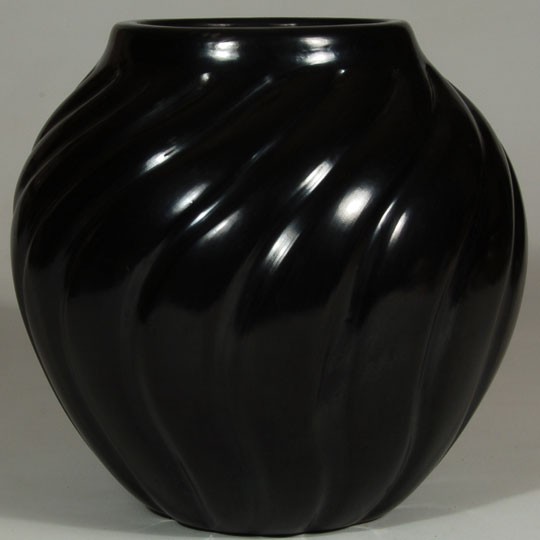 Jars with melon ribs are fashioned after melons such as cantaloupe. Whether cantaloupe was the inspiration for such jars is not known but it certainly is suspected. Several potters from Santa Clara Pueblo have in the past made melon jars, but Angela Baca is among the best known for doing so. She is most likely represented in every collection of contemporary pottery with one of her black melon jars, the style and shape that has been associated with her since the 1960s. She was quite likely the first potter to produce them.
Jars with melon ribs are fashioned after melons such as cantaloupe. Whether cantaloupe was the inspiration for such jars is not known but it certainly is suspected. Several potters from Santa Clara Pueblo have in the past made melon jars, but Angela Baca is among the best known for doing so. She is most likely represented in every collection of contemporary pottery with one of her black melon jars, the style and shape that has been associated with her since the 1960s. She was quite likely the first potter to produce them.
Stone Polished Red Melon-ribbed Wedding Vase by Helen Shupla - C3792C
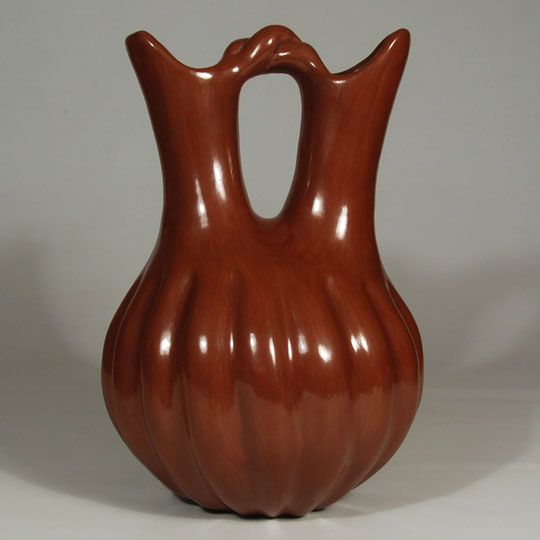 If Helen Shupla left her mark, it was due to her masterful creation of jars with melon ribs. She developed a technique of pushing the melon ribs outward from the inside while she was building the jar with coils of clay. She produced jars in all black, all red, and all tan. The entire surface of the vessel was then stone polished.
If Helen Shupla left her mark, it was due to her masterful creation of jars with melon ribs. She developed a technique of pushing the melon ribs outward from the inside while she was building the jar with coils of clay. She produced jars in all black, all red, and all tan. The entire surface of the vessel was then stone polished.

